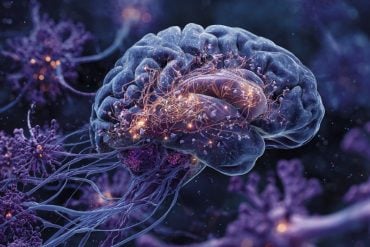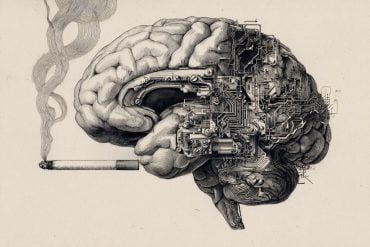Summary: A prosthetic arm that is attached to the bone and controlled by electrodes implanted in nerves and muscles can operate more precisely than conventional prosthetic limbs. Researchers improved the neuroprosthetic limb by integrating tactile sensory feedback, so the patient can “feel” items.
Source: Chalmers University of Technology
For the first time, people with arm amputations can experience sensations of touch in a mind-controlled arm prosthesis that they use in everyday life. A study in the New England Journal of Medicine reports on three Swedish patients who have lived, for several years, with this new technology – one of the world’s most integrated interfaces between human and machine.
The advance is unique: the patients have used a mind-controlled prosthesis in their everyday life for up to seven years. For the last few years, they have also lived with a new function – sensations of touch in the prosthetic hand. This is a new concept for artificial limbs, which are called neuromusculoskeletal prostheses – as they are connected to the user’s nerves, muscles, and skeleton.
The research was led by Max Ortiz Catalan, Associate Professor at Chalmers University of Technology, in collaboration with Sahlgrenska University Hospital, University of Gothenburg, and Integrum AB, all in Gothenburg, Sweden. Researchers at Medical University of Vienna in Austria and the Massachusetts Institute of Technology in the USA were also involved.
“Our study shows that a prosthetic hand, attached to the bone and controlled by electrodes implanted in nerves and muscles, can operate much more precisely than conventional prosthetic hands. We further improved the use of the prosthesis by integrating tactile sensory feedback that the patients use to mediate how hard to grab or squeeze an object. Over time, the ability of the patients to discern smaller changes in the intensity of sensations has improved,” says Max Ortiz Catalan.
“The most important contribution of this study was to demonstrate that this new type of prosthesis is a clinically viable replacement for a lost arm. No matter how sophisticated a neural interface becomes, it can only deliver real benefit to patients if the connection between the patient and the prosthesis is safe and reliable in the long term. Our results are the product of many years of work, and now we can finally present the first bionic arm prosthesis that can be reliably controlled using implanted electrodes, while also conveying sensations to the user in everyday life”, continues Max Ortiz Catalan.
Since receiving their prostheses, the patients have used them daily in all their professional and personal activities.
The new concept of a neuromusculoskeletal prosthesis is unique in that it delivers several different features which have not been presented together in any other prosthetic technology in the world:
- It has a direct connection to a person’s nerves, muscles, and skeleton.
- It is mind-controlled and delivers sensations that are perceived by the user as arising from the missing hand.
- It is self-contained; all electronics needed are contained within the prosthesis, so patients do not need to carry additional equipment or batteries.
- It is safe and stable in the long term; the technology has been used without interruption by patients during their everyday activities, without supervision from the researchers, and it is not restricted to confined or controlled environments.
The newest part of the technology, the sensation of touch, is possible through stimulation of the nerves that used to be connected to the biological hand before the amputation. Force sensors located in the thumb of the prosthesis measure contact and pressure applied to an object while grasping. This information is transmitted to the patients’ nerves leading to their brains. Patients can thus feel when they are touching an object, its characteristics, and how hard they are pressing it, which is crucial for imitating a biological hand.
“Currently, the sensors are not the obstacle for restoring sensation,” says Max Ortiz Catalan. “The challenge is creating neural interfaces that can seamlessly transmit large amounts of artificially collected information to the nervous system, in a way that the user can experience sensations naturally and effortlessly.”
The implantation of this new technology took place at Sahlgrenska University Hospital, led by Professor Rickard Brånemark and Doctor Paolo Sassu. Over a million people worldwide suffer from limb loss, and the end goal for the research team, in collaboration with Integrum AB, is to develop a widely available product suitable for as many of these people as possible.

“Right now, patients in Sweden are participating in the clinical validation of this new prosthetic technology for arm amputation,” says Max Ortiz Catalan. “We expect this system to become available outside Sweden within a couple of years, and we are also making considerable progress with a similar technology for leg prostheses, which we plan to implant in a first patient later this year.”
More about: How the technology works:
The implant system for the arm prosthesis is called e-OPRA and is based on the OPRA implant system created by Integrum AB. The implant system anchors the prosthesis to the skeleton in the stump of the amputated limb, through a process called osseointegration (osseo = bone). Electrodes are implanted in muscles and nerves inside the amputation stump, and the e-OPRA system sends signals in both directions between the prosthesis and the brain, just like in a biological arm.
The prosthesis is mind-controlled, via the electrical muscle and nerve signals sent through the arm stump and captured by the electrodes. The signals are passed into the implant, which goes through the skin and connects to the prosthesis. The signals are then interpreted by an embedded control system developed by the researchers. The control system is small enough to fit inside the prosthesis and it processes the signals using sophisticated artificial intelligence algorithms, resulting in control signals for the prosthetic hand’s movements.
The touch sensations arise from force sensors in the prosthetic thumb. The signals from the sensors are converted by the control system in the prosthesis into electrical signals which are sent to stimulate a nerve in the arm stump. The nerve leads to the brain, which then perceives the pressure levels against the hand.
Credit: Chalmers University of Technology.
The neuromusculoskeletal implant can connect to any commercially available arm prosthesis, allowing them to operate more effectively.
More about: How the artificial sensation is experienced:
People who lose an arm or leg often experience phantom sensations, as if the missing body part remains although not physically present. When the force sensors in the prosthetic thumb react, the patients in the study feel that the sensation comes from their phantom hand. Precisely where on the phantom hand varies between patients, depending on which nerves in the stump receive the signals. The lowest level of pressure can be compared to touching the skin with the tip of a pencil. As the pressure increases, the feeling becomes stronger and increasingly ‘electric’.
More about: The research:
The current study dealt with patients with above-elbow amputations, and this technology is close to becoming a finished product. The research team is working in parallel with a new system for amputations below the elbow. In those cases, instead of one large bone (humerus), there are two smaller bones (radius and ulna) to which the implant needs to be anchored. The group is also working on adapting the system for leg prostheses.
In addition to applications within prosthetics, the permanent interface between human and machine provides entirely new opportunities for scientific research into how the human muscular and nervous systems work.
Associate Professor Max Ortiz Catalan heads the Biomechatronics and Neurorehabilitation Laboratory at Chalmers University of Technology and is currently establishing the new Center for Bionics and Pain Research at Sahlgrenska University Hospital, in close collaboration with Chalmers and the University of Gothenburg, where this work will be further developed and clinically implemented.
Funding: The research has been funded by the Promobilia Foundation, the IngaBritt and Arne Lundbergs Research Foundation, Region Västra Götaland (ALF grants), Vinnova, the Swedish Research Council, and the European Research Council.
About this neuroscience research article
Source:
Chalmers University of Technology
Media Contacts:
Johanna Wilde – Chalmers University of Technology
Image Source:
The image is credited to Johan Bodell/Chalmers University of Technology.
Original Research: Closed access
“Self-Contained Neuromusculoskeletal Arm Prostheses”. by Max Ortiz-Catalan, Ph.D., Enzo Mastinu, Ph.D., Paolo Sassu, M.D., Oskar Aszmann, M.D., and Rickard Brånemark, M.D., Ph.D.
New England Journal of Medicine doi:10.1056/NEJMoa1917537
Abstract
Self-Contained Neuromusculoskeletal Arm Prostheses
We report the use of a bone-anchored, self-contained robotic arm with both sensory and motor components over 3 to 7 years in four patients after transhumeral amputation. The implant allowed for bidirectional communication between a prosthetic hand and electrodes implanted in the nerves and muscles of the upper arm and was anchored to the humerus through osseointegration, the process in which bone cells attach to an artificial surface without formation of fibrous tissue. Use of the device did not require formal training and depended on the intuitive intent of the user to activate movement and sensory feedback from the prosthesis. Daily use resulted in increasing sensory acuity and effectiveness in work and other activities of daily life.
Feel Free To Share This Neuroprosthetics News.






